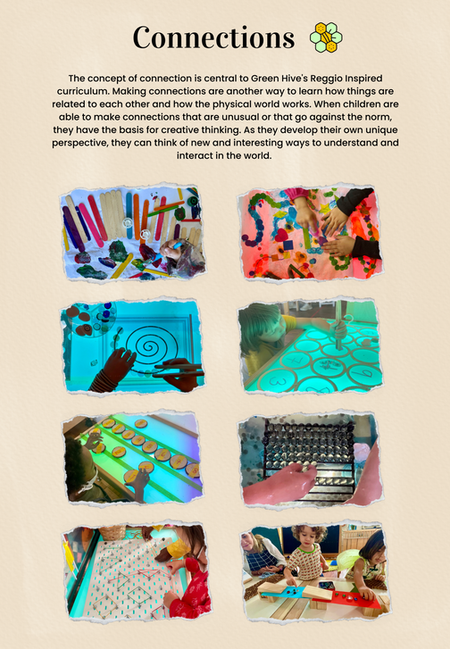Educational Approach & Philosophy
Welcome to Green Hive
At Green Hive, we believe that every child enters the world brimming with curiosity, ideas, and the capacity to make sense of their world. Our work is guided by the Reggio Emilia philosophy, which honors children as capable, creative, and full of potential. We see learning as a joyful, collaborative process, one that thrives in a community built on relationships, respect, and wonder.

The Image of the Child
In many traditional models of education, children are seen as “empty vessels” waiting to be filled with knowledge, as if they are incomplete until adults pour information into them. In the Reggio Emilia philosophy, this view is turned on its head.
We see children as whole people from the very beginning—capable of deep thought, complex emotions, and meaningful contributions to their community. This is a radical shift because it demands that we listen to children, respect their ideas, and involve them as active participants in their own learning, rather than simply preparing them for a distant future.
The Role of the Environment
In Reggio Emilia, the environment is often called the “third teacher.” Our space is intentionally designed and curated to inspire curiosity and creativity, filled with natural light, open-ended materials, and areas for both active play and quiet reflection.
Every shelf, table, and display is arranged to invite investigation, encourage independence, and spark new ideas. The beauty and order of the classroom send children a message: this is your space, your ideas matter here.


The Role of Teacher
Our teachers are researchers, guides, and co-learners. We observe attentively, listen closely, and ask thoughtful questions that deepen children’s thinking. Instead of simply providing answers, we create opportunities for children to test ideas, solve problems, and express themselves in many ways—through art, construction, storytelling, movement, and more. Our role is to nurture curiosity, scaffold learning, and celebrate each child’s unique way of seeing the world.
Making Learning Visible Through Documentation
In our classrom and atelier, you’ll find documentation, photographs, children’s words, work samples, and teacher reflections. Documentation captures the learning process, not just the end product. It invites children to revisit and extend their thinking, helps teachers plan meaningful next steps, and invites families into their child’s learning journey. In this way, learning becomes visible, celebrated, and shared.


The Power of Community
In the Reggio Emilia philosophy, learning thrives in the context of relationships—between children, teachers, families, and the wider community. We see parents not just as observers, but as partners, collaborators, and advocates in their child’s education. Open communication, shared decision-making, and opportunities for families to contribute their talents all strengthen the bonds between home and school. This partnership helps children feel secure, valued, and connected, while weaving a richer and more meaningful learning environment for everyone.
The 100 Languages of Children
The Reggio Emilia concept of “the 100 languages” celebrates the many ways children think, express, and make meaning—through art, movement, storytelling, music, play, and more. Each language is valued equally, often blending together in rich, creative ways. A child exploring a science concept might sing about it, draw it, act it out, and build it—making learning fluid, personal, and deeply meaningful.

How Learning Happens: Emergent Curriculum
We follow an emergent approach to build our curriculum, which means our plans grow out of children’s interests, questions, and real-life experiences. If children become fascinated with shadows, we might investigate light sources, create shadow art, measure shadows outdoors, and read shadow-themed stories. This ensures learning is engaging and relevant to the children, because it begins with genuine curiosity.
Emergent learning does not mean “anything goes.” Behind the scenes, our teachers connect every exploration to New York State Early Learning Standards. Whether children are studying insects, building structures, or cooking together, they are also developing gross motor skills, language, cognitive skills, problem solving, social-emotional, and the arts. This approach ensures that academic foundations grow naturally out of meaningful experiences, without losing the joy and wonder that drive true learning.


